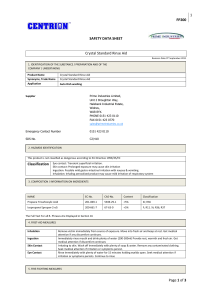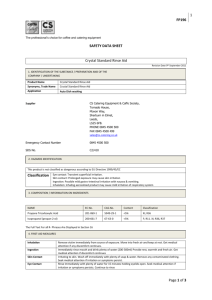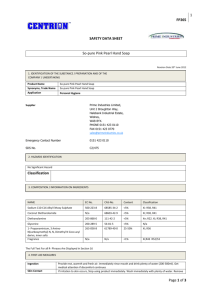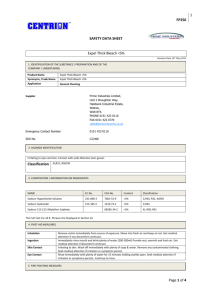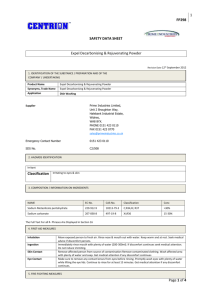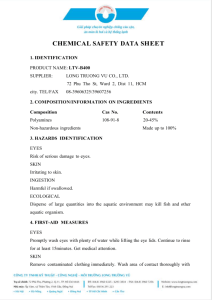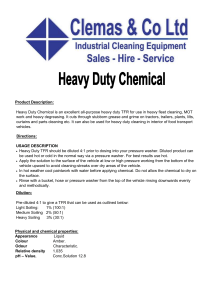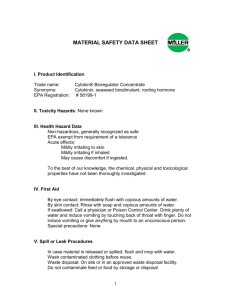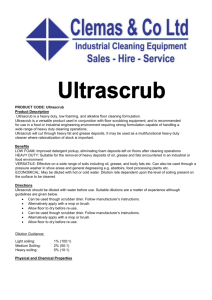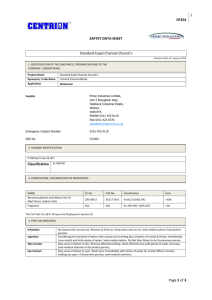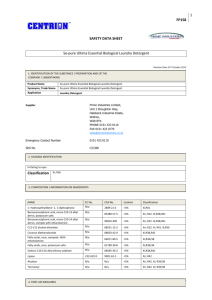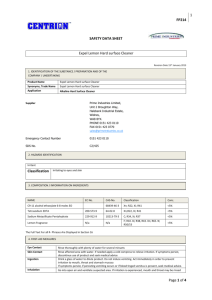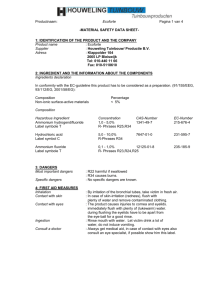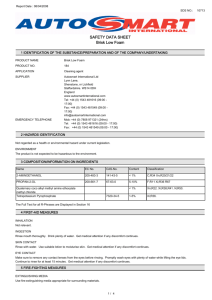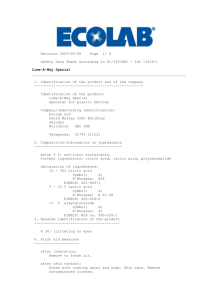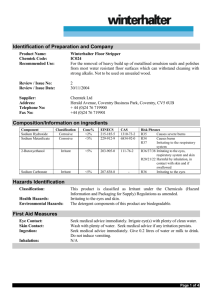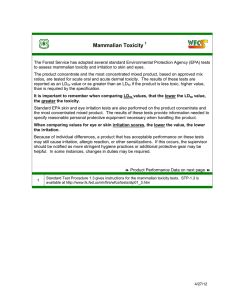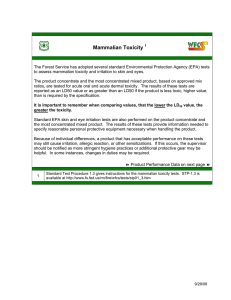Heavy Duty Low Foam Scrubber Drier Detergent
advertisement
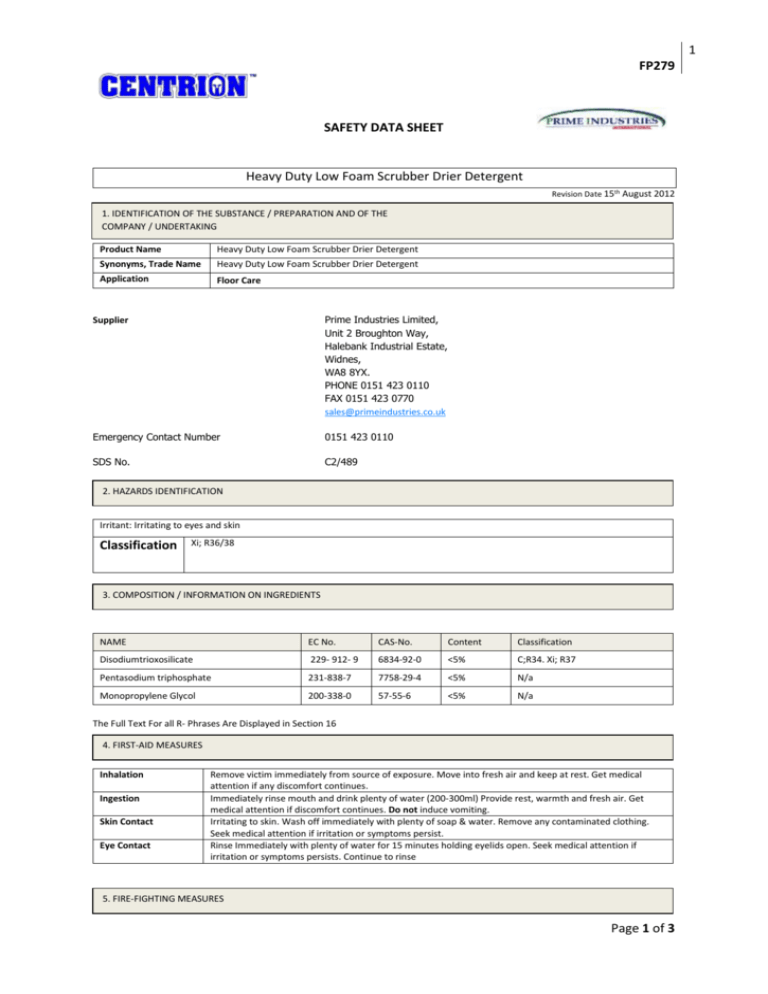
1 FP279 SAFETY DATA SHEET Heavy Duty Low Foam Scrubber Drier Detergent Revision Date 15th August 2012 1. IDENTIFICATION OF THE SUBSTANCE / PREPARATION AND OF THE COMPANY / UNDERTAKING Product Name Heavy Duty Low Foam Scrubber Drier Detergent Synonyms, Trade Name Heavy Duty Low Foam Scrubber Drier Detergent Application Floor Care Supplier Prime Industries Limited, Unit 2 Broughton Way, Halebank Industrial Estate, Widnes, WA8 8YX. PHONE 0151 423 0110 FAX 0151 423 0770 sales@primeindustries.co.uk Emergency Contact Number 0151 423 0110 SDS No. C2/489 2. HAZARDS IDENTIFICATION Irritant: Irritating to eyes and skin Classification Xi; R36/38 3. COMPOSITION / INFORMATION ON INGREDIENTS NAME EC No. CAS-No. Content Classification Disodiumtrioxosilicate 229- 912- 9 6834-92-0 <5% C;R34. Xi; R37 Pentasodium triphosphate 231-838-7 7758-29-4 <5% N/a Monopropylene Glycol 200-338-0 57-55-6 <5% N/a The Full Text For all R- Phrases Are Displayed in Section 16 4. FIRST-AID MEASURES Inhalation Ingestion Skin Contact Eye Contact Remove victim immediately from source of exposure. Move into fresh air and keep at rest. Get medical attention if any discomfort continues. Immediately rinse mouth and drink plenty of water (200-300ml) Provide rest, warmth and fresh air. Get medical attention if discomfort continues. Do not induce vomiting. Irritating to skin. Wash off immediately with plenty of soap & water. Remove any contaminated clothing. Seek medical attention if irritation or symptoms persist. Rinse Immediately with plenty of water for 15 minutes holding eyelids open. Seek medical attention if irritation or symptoms persists. Continue to rinse 5. FIRE-FIGHTING MEASURES Page 1 of 3 2 FP279 Extinguishing Media Use: Unusual Fire & Explosion Hazards Use fire-extinguishing media appropriate for surrounding materials. None Specific Hazard Burning produces irritating, toxic and obnoxious fumes Protective Measures in Fire Self contained breathing apparatus and ful protective clothing must be worn in case of fire 6. ACCIDENTAL RELEASE MEASURES Personal Precautions Wear suitable protective equipment Environmental Precautions Do not allow products to enter into surface water drains, Prevent further spillage if safe to do so. Spill Cleanup Methods Absorb with inert, absorbent material. Sweep up. Transfer to suitable labelled containers for disposal. Clean spillage area with thoroughly with plenty of water. 7. HANDLING AND STORAGE Usage Precautions Storage Precautions Avoid contact with eyes & skin. Adopt best Manual Handling consideration when handling, carrying and dispensing. Keep in a cool, dry, well ventilated area. Keep container tightly closed. Store in correctly labelled containers 8. EXPOSURE CONTROLS / PERSONAL PROTECTION Protective Equipment Respiratory Equipment If ventilation is insufficient, suitable respiratory protection is advised Hand Protection Chemical resistant gloves (PVC) Eye Protection Other Protection Engineering Measures Hygiene Measures Approved glasses / goggles Overalls, wear rubber apron, wear rubber footwear Ensure well ventilated working area Do Not Smoke In Work Area! Wash at the end of each work shit and before eating, smoking and using the toilet. Wash promptly if skin becomes contaminated. Promptly remove any clothing that becomes contaminated. When using do not eat, drink or smoke. 9. PHYSICAL AND CHEMICAL PROPERTIES Appearance Liquid Colour Red Odour Low odour Solubility In water Boiling Point >100°C Viscosity ~75 mPas. 20 pH-value, Conc. Solution 11-13.5 10. STABILITY AND REACTIVITY Stability Conditions To Avoid Materials To Avoid Hazardous Decomposition products Stable under normal temperature conditions and recommended use. Heat, Direct sunlight, Do not allow to freeze Strong acids. Other halogenated organics Hydrogen 11. TOXICOLOGICAL INFORMATION Inhalation In high concentrations vapours may irritate throat and respiratory system and cause coughing Ingestion May cause chemical burns in mouth, oesophagus and stomach Page 2 of 3 3 FP279 Skin Contact Irritating to skin Eye Contact Risk of damage to eyes 12. ECOLOGICAL INFORMATION Eco toxicity The product components are not classified as environmentally hazardous. However, this does not exclude the possibility that large or frequent spills can have a harmful effect on the environment. This product is soluble in water This product is expected to be biodegradable Mobility Degradability 13. DISPOSAL CONSIDERATIONS General Information Consumer products ending up down the drain after use. Observe safe handling precautions and local legislation 14. TRANSPORT INFORMATION Not subject to ADR / IATA / IMDG Codes 15. REGULATORY INFORMATION Labelling Contains Risk Phrases Safety Phrases Statutory Instruments Approved Code of Practice Guidance Notes Irritant Disodiumtrioxosilicate R36/38 – Irritating to eyes and skin S2 Keep out of reach of children S24/25 Avoid contact with skin and eyes. S26 In case of contact with eyes, rinse immediately with plenty of water and seek medical advice. Chemicals (Hazard information and packaging) regulations Safety data sheets of substances and preparations. Classification and labelling of substances and preparations dangerous to supply CHIP for everyone HSG (108). Workplace Exposure Limits EH40 16. OTHER INFORMATION REV. No. / REPL. SDS Generated SDS No. Safety Data Sheet Status Approved. Signature Risk Phrases in Full Notes 15th August 2012 C2/489 15th August 2012 R34 – Causes Burns R37 – Irritating to respiratory system This information relates only to the specific material designed and may not be valid for such material used in combination with any other materials or in any process. Such information is to the best of the company’s knowledge and belief, accurate and reliable as of date indicated. However, no warranty, guarantee or representation is made as to its accuracy, reliability or completeness. It is the user’s responsibility to satisfy himself as to the suitability of such information for his own particular use. Page 3 of 3
